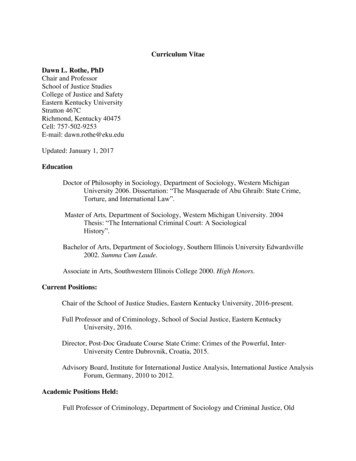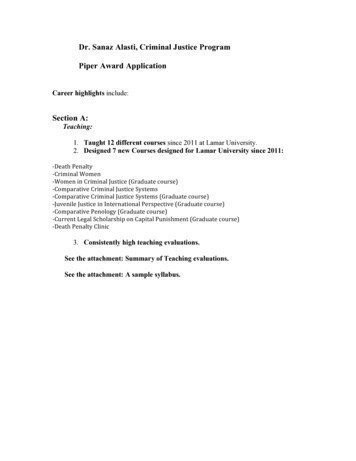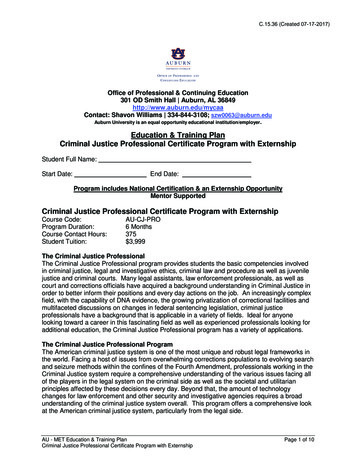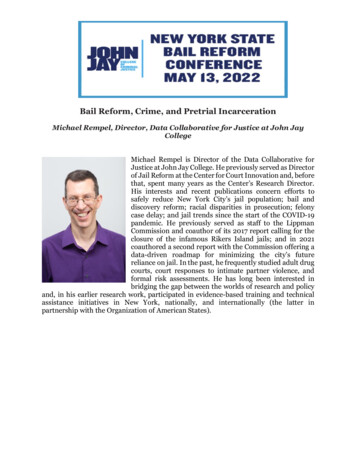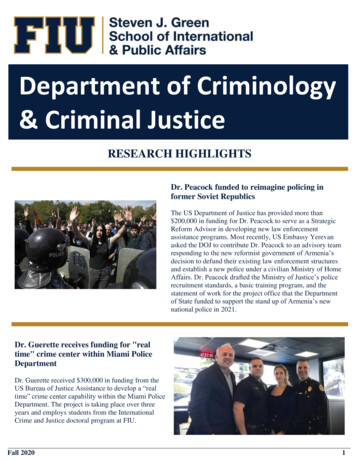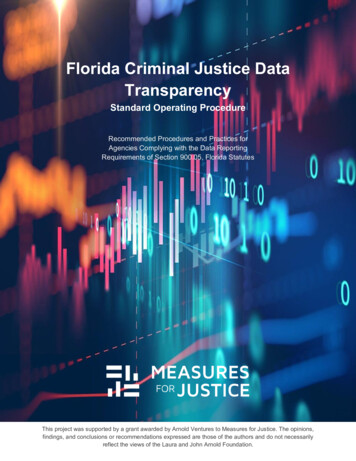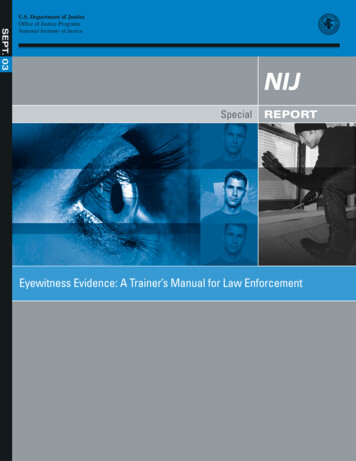
Transcription
SEPT. 03U.S. Department of JusticeOffice of Justice ProgramsNational Institute of JusticeSpecialREPORTEyewitness Evidence: A Trainer’s Manual for Law Enforcement
U.S. Department of JusticeOffice of Justice Programs810 Seventh Street N.W.Washington, DC 20531John AshcroftAttorney GeneralDeborah J. DanielsAssistant Attorney GeneralSarah V. HartDirector, National Institute of JusticeThis and other publications and products of the U.S. Departmentof Justice, Office of Justice Programs, National Institute of Justicecan be found on the World Wide Web at the following site:Office of Justice ProgramsNational Institute of Justicehttp://www.ojp.usdoj.gov/nij
Eyewitness Evidence:A Trainer‘s Manual for Law EnforcementDeveloped by theTechnical Working Group for Eyewitness EvidenceSeptember 2003
Sarah V. HartDirectorThis document is not intended to create, does not create, and may not be relied upon to create any rights,substantive or procedural, enforceable at law by any party in any matter, civil or criminal.Opinions or points of view expressed in this document represent a consensus of the authors and do notreflect the official position of the U.S. Department of Justice.NCJ 188678The National Institute of Justice is a component of the Office of Justice Programs, which also includes theBureau of Justice Assistance, the Bureau of Justice Statistics, the Office of Juvenile Justice and DelinquencyPrevention, and the Office for Victims of Crime.
Technical Working Group for EyewitnessEvidence: Training TeamsThe Technical Working Group for Eyewitness Evidence (TWGEYEE), a multidisciplinary groupof content-area experts from across the United States and Canada, was created by the NationalInstitute of Justice (NIJ) in 1998 to develop recommended procedures for law enforcement usein investigations involving eyewitness evidence. These individuals, led by a Planning Panel composed of distinguished law enforcement, legal, and research professionals, authored the 1999 NIJResearch Report, Eyewitness Evidence: A Guide for Law Enforcement.The TWGEYEE Training Teams were formed in early 2000 as subgroups of TWGEYEE to developthe materials found in this Trainer’s Manual. Two teams were formed—one to develop a lessonplan and accompanying materials for eyewitness interviewing procedures and another to develop a lesson plan and accompanying materials for identification procedures. Leading law enforcement and research members of the TWGEYEE Planning Panel were designated as team chairswho selected additional team members from the TWGEYEE membership base. These team members, listed below, worked together over a 1-year period to author the Trainer’s Manual.Interviewing TeamIdentification TeamChairsChairsAlternateSgt. Paul Carroll (Ret.)*Chicago Police DepartmentBig Pine Key, FloridaDet. Lt. Kenneth A. Patenaude*Northampton Police DepartmentNorthampton, MassachusettsSolomon M. Fulero, Ph.D., J.D.Sinclair CollegeDayton, OhioRonald P. Fisher, Ph.D.*Florida International UniversityNorth Miami, FloridaGary L. Wells, Ph.D.*Iowa State UniversityAmes, IowaMembersMembersCaterina DiTragliaAssistant Federal DefenderSt. Louis, MissouriCpl. Daniel Alarcon IIHillsborough County Sheriff’s OfficeTampa, FloridaMark R. Larson*King County Prosecutor’s OfficeSeattle, WashingtonHon. Michael J. BarrasseLackawanna County JudgeScranton, PennsylvaniaRoy S. Malpass, Ph.D.University of Texas at El PasoEl Paso, TexasDavid C. NiblackAttorney at LawWashington, D.C.Eugene RifenburgNew York State Police (Ret.)Oneida Indian Nation PoliceMunnsville, New YorkJohn Turtle, Ph.D.Ryerson Polytechnic UniversityToronto, Ontario*Planning Panel memberTechnical Working Group for Eyewitness Evidence: Training Teamsiii
Members of TWGEYEE reviewed the materials contained in this manual and provided valuableinput during the preliminary development of the training criteria on which the lesson plans in thismanual are built. These members are listed alphabetically below:First Sgt. Roger BroadbentVirginia State PoliceFairfax Station, VirginiaJames Doyle*Attorney at LawBoston, MassachusettsJeralyn MerrittAttorney at LawDenver, ColoradoCdr. Ella M. Bully (Ret.)*Detroit Police DepartmentDetroit, MichiganJames FoxSan Mateo County District AttorneyRedwood City, CaliforniaMelissa Mourges*New York County DistrictAttorney’s OfficeNew York, New YorkCpl. J.R. BurtonHillsborough County Sheriff’s OfficeTampa, FloridaInvestigations Chief Arlyn GreydanusMontana Department of JusticeDivision of Criminal InvestigationHelena, MontanaPatricia RamirezDodge County District AttorneyJuneau, WisconsinInvestigator Kathy GriffinLoveland Police DepartmentLoveland, ColoradoDet. Edward Rusticus (Ret.)Kent County Sheriff’s OfficeGrand Rapids, MichiganWilliam HodgmanLos Angeles County DistrictAttorney’s OfficeLos Angeles, CaliforniaDet. Ray StaleyKansas City Police DepartmentKansas City, MissouriDet. Sgt. Chet BushKent County Sheriff’s OfficeGrand Rapids, MichiganCarole E. Chaski, Ph.D.*Institute for Linguistic EvidenceGeorgetown, DelawareLt. Rosanna Church-AbreoTexas Department of Public SafetySpecial Crime ServicesAustin, TexasDet. Sgt. J. Glenn Diviney (Ret.)Tarrant County Sheriff’s OfficeFort Worth, TexasRod C.L. Lindsay, Ph.D.Queen’s UniversityKingston, OntarioOfficer Patricia MarshallChicago Police DepartmentChicago, IllinoisLt. Tami ThomasAtlantic Beach Police DepartmentAtlantic Beach, North CarolinaCapt. Michael B. WallNorthampton Police DepartmentNorthampton, Massachusetts*Planning Panel memberivEyewitness Evidence: A Trainer’s Manual for Law Enforcement
ForewordEyewitnesses play a critical role in our criminal justice system. They are often essential to identifying, charging, and ultimately convicting perpetrators of crime and in some cases may providethe sole piece of evidence against those individuals. For these reasons, the value of accurate andreliable eyewitness evidence cannot be overstated.Cases in which DNA testing has exonerated individuals convicted on the basis of eyewitness testimony tend to make headlines, but in actuality, the frequency of mistaken eyewitness identificationsis quite small. The vast majority of eyewitness identifications are accurate and provide trustworthyevidence for the trier of fact.Recognizing the weight accorded eyewitness evidence by judges and juries, the National Instituteof Justice initiated a project in 1998 to research methods to improve the accuracy, reliability, andavailability of information obtained from eyewitnesses. The Technical Working Group for Eyewitness Evidence (TWGEYEE), composed of experienced law enforcement investigators, prosecutors,defense lawyers, and psychology researchers, worked together to produce recommendations forthe collection and preservation of this vital evidence. These consensus recommendations wereincluded in the 1999 NIJ publication Eyewitness Evidence: A Guide for Law Enforcement.Because of the complex issues associated with identification practices, TWGEYEE recognized thatits recommendations may not be feasible in all circumstances. The Guide’s recommendations arenot legal mandates or policy directives, nor do they represent the only correct courses of action.Rather, the recommendations represent a consensus of the diverse views and experiences of thetechnical working group members, who have provided valuable insight into these important issues.We expect that each jurisdiction will be able to use these recommendations to spark debate andensure that its practices and procedures are best suited to its unique environment.Law enforcement personnel can benefit from training based on the procedures recommended inthe Guide. To assist law enforcement trainers with creating and instructing courses on eyewitnessevidence, including the topics of interviewing witnesses and conducting lineups, TWGEYEE hasdeveloped the materials included herein. These detailed curriculum plans provide instructors withexplanations grounded in research and practical exercises that can enhance learning. For example,this trainer’s manual includes a CD–ROM that can be used to guide students through compositionof a mock photo lineup. It is our hope that, through these materials, more of our Nation’s lawenforcement personnel will be trained to work effectively with eyewitnesses and maximize thereliable evidence obtained from them, to the benefit of criminal case prosecutions.NIJ extends its appreciation to the Baltimore County (Maryland) Police Department and the MidAtlantic Regional Community Policing Institute (MARCPI) for their willingness to test the trainingmaterials included in this manual—as well as their time and effort in doing so—in the interest ofdelivering a better product to the Nation’s law enforcement community. NIJ is particularly gratefulfor the support of those who orchestrated and carried out the pilot testing of this manual: CaptainHoward Hall, Sergeants Theresa McQuaid, Samuel Hannigan, and Melvin Teal, and Officers ScottForewordv
Leonard and James Moss of the Baltimore County Police Department Training Academy; DirectorWilliam Rogers of MARCPI; and Karl Bickel of the U.S. Department of Justice’s Office of CommunityOriented Policing Services. Thanks also are extended to the many law enforcement and legal practitioners from the Baltimore-Washington area who attended the pilot training course and providedvaluable suggestions to refine these materials. Special thanks are extended to Detective LieutenantKenneth Patenaude of the Northampton (Massachusetts) Police Department for his selfless effortsin developing the CD–ROM that accompanies this manual. Finally, we thank the members of theTWGEYEE Training Panel for their extensive efforts on this project and their dedication to strengthening the value of eyewitness evidence in the criminal justice system, as well as the originalTWGEYEE members, who continued their commitment to this project by reviewing and commenting on this manual throughout its development stages. We believe that the overall improvementin professional practices that will result from this project will ultimately lead to stronger evidencefor criminal cases and reliable verdicts.The TWGEYEE members have dedicated their work to the memory of David C. Niblack—steadfastworking group member, devoted advocate, and also, friend.Sarah V. HartDirector, National Institute of JusticeviEyewitness Evidence: A Trainer’s Manual for Law Enforcement
ContentsTechnical Working Group for Eyewitness Evidence: Training Teams .iiiForeword .vAbout This Manual .1Sample Lesson Plan: Interviewing .7Sample Lesson Plan: Identification .25Further Reading .53Contentsvii
Trainers should carefully read thismanual in its entirety before attemptingto teach this material.
About This ManualPurpose of the Trainer‘s ManualThis manual is written for law enforcement trainers to accompany Eyewitness Evidence: A Guidefor Law Enforcement (hereafter, the Guide). It is presumed that the law enforcement students inthe course will each have a copy of (or access to) the Guide. This manual and the accompanyingCD–ROM are designed to facilitate trainers’ teaching of the Guide in two ways.First, this manual provides much of the context for understanding why the procedures describedin the Guide for the collection and preservation of eyewitness evidence may enhance the reliabilityof this evidence. Although the procedures described in the Guide are relatively easy to follow, it isuseful for trainers to understand why procedures are important and to communicate these reasons to the students.Second, the CD–ROM includes a multimedia presentation that can supplement trainers’ discussion.The presentation includes a number of exercises and demonstrations to promote students’ understanding of the material and to make the training sessions more interactive and interesting forthe students.Development of the Trainer‘s ManualThis manual was developed by a panel of law enforcement practitioners, psychology researchers,prosecutors, and defense lawyers who served as members of the Technical Working Group forEyewitness Evidence (TWGEYEE). The panel used a consensus-building process similar to thatemployed in developing the Guide to write the instructor’s notes and explanations included in thismanual. All material was reviewed by TWGEYEE as well as a network of national organizations, lawenforcement agencies, and individuals concerned with the training of investigators. Commentsfrom these reviewers were considered by the panel and incorporated as appropriate.The sample lesson plans and materials included in this manual were pilot tested by police traininginstructors in an authentic classroom environment. This pilot testing was completed in September2000 at the Baltimore County (Maryland) Police Department Training Academy as part of a 2-daytraining course for law enforcement and legal practitioners and trainers. Instructor and studentevaluation forms were completed, and feedback sessions with the authors of the manual were heldat the end of each day to assess the utility and effectiveness of the lesson plans and training materials. Further refinements to this manual were accomplished as a result of the pilot testing.About This Manual1
Organization of the Trainer‘s ManualThe manual is divided into two sections: Interviewing and Identification. These sections providesample lesson plans that relate directly to the interview and identification procedures contained inthe Guide. In these sections, the procedural portion of the Guide is reprinted in black, with explanations for the instructor’s reference included in blue following the procedures themselves. Instructors should describe the rationale for each procedure at the time each procedure is discussed.Information in the “notes” column (also printed in blue) suggests exercises, demonstrations, anddiscussion ideas that correspond to the procedures, as well as key points that should be highlighted during classroom discussion. The notes column also includes references to the contents of theaccompanying CD–ROM.The CD–ROM includes a multimedia presentation that follows the procedural content of the Guide. Itsuse is highly recommended because it includes audio/visual aides and exercises that can be effectiveteaching tools. Instructors are, of course, encouraged to incorporate their own materials as desired.The CD–ROM also includes an Adobe Acrobat (.pdf) file of the Guide, which can be printed andphotocopied for students in the event that actual Guides are not available. An executable versionof Adobe Acrobat Reader (.exe) is included on the CD–ROM for instructors’ convenience.Use of the Trainer‘s ManualThe material in this manual is designed either to supplement existing training programs or to beused on its own. Each component of the Interviewing and Identification sections may be taughtindependently as needed for different audiences (e.g., dispatchers, first responders, investigators,interviewers, lineup administrators).When conducting a training course using this manual, the instructors’ explanations in blue text shouldbe used to clarify for students the reasoning behind each procedure. The instructors’ explanationsoften include practical examples of what can go wrong if procedures are not followed, which help to“drive home” the importance of each step for students. Key points and clarifications are highlightedin the notes column to draw instructors’ attention to critical information. Instructors should use thisinformation to facilitate students’ learning, understanding, and skills. The notes column, as the nameimplies, is also useful for instructors to make notes to themselves for future training sessions.Instructors should keep in mind that students will have access to the Guide itself, rather than thismanual. As a practical consideration (particularly in courses operating within strict time limitations),it is more important to emphasize procedural reasoning and examples as included in the instructors’explanations than to read verbatim the text of the Guide. In particular, “Principle,” “Policy,” and“Summary” statements need not be read to the class. A simple summary of each section’s importance can be provided by the instructor.Instructors may note that some departures have been made from the text of the Guide in certainareas of this manual. These departures reflect that the performance of every procedure may not befeasible or appropriate in all jurisdictions or in all situations. Instructors may choose to mentionthese caveats to students as appropriate.2Eyewitness Evidence: A Trainer’s Manual for Law Enforcement
The CD–ROM presentation that accompanies this manual can be used with a laptop computer and LCD(liquid crystal display) projector to enhance training. The audio/visual aides and exercises included inthe presentation are referenced in the manual’s notes column at points where their use is most beneficial. Links to audio files appear as numbered loudspeaker icons on the presentation slides. Video filesappear as separate slides that contain the first frame of the video. To play the audio and video files, theinstructor need only move the cursor over the icon or frame.Instructors should familiarize themselves thoroughly with this manual before attempting to trainlaw enforcement students on the Guide’s procedures. Instructors are encouraged to direct questions and suggestions regarding both the Guide and this manual to the National Institute of Justice(askost@ojp.usdoj.gov). Such feedback from law enforcement trainers will be valuable for any futureupdates of these materials.About This Manual3
The procedures contained in this manual are intended asexamples of suggested practices for the collection andpreservation of eyewitness evidence.Departmental, logistical, or budget/staff limitations or legalconditions may make the use of particular procedurescontained herein impracticable.Instructors are encouraged to modify these materials asappropriate for their jurisdiction and classroom presentation.
A. Answering the 9–1–1/Emergency Call (Call-Taker/Dispatcher)Sample Lesson Plan:InterviewingRole-playing is used in this lesson plan as a tool to facilitate students’learning of effective interview techniques. With classes of up to 25 students, use role-playing exercises in which all students rotate through theroles of interviewer/call-taker and witness. With classes of more than 25students, select two volunteers to go through role-playing exercises forthe class to observe.Show Slide 1Instruct the student playing the role of the witness to think of an actualevent that he/she experienced approximately 6 months earlier. Usingmemory of an actual event in these exercises will more effectivelydemonstrate the utility of the interview procedures contained herein.To maximize the educational benefit of the exercise, the procedural pointbeing demonstrated should be explained prior to the role-playing exercise.Section I. Initial Report of the Crime/FirstResponder (Preliminary Investigator)A. Answering the 9–1–1/Emergency Call (Call-Taker/Dispatcher)Principle: As the initial point of contact for the witness, the 9–1–1/emergency call-taker or dispatcher should obtain and disseminate, in a nonsuggestive manner, complete and accurate information from the caller.This information can include the description/identity of the perpetratorof a crime. The actions of the call-taker/dispatcher can affect the safetyof those involved as well as the entire investigation.Show Slide 2NOTE:Instructors areencouraged to play anaudiotaped exampleof an actual 9–1–1call for classroomdiscussion.Policy: The call-taker/dispatcher should answer each call in a mannerconducive to obtaining and disseminating accurate information regarding the crime and the description/identity of the perpetrator.Procedure: During a 9–1–1/emergency call—after obtaining preliminaryShow Slide 3information and dispatching police—the call-taker/dispatcher should—1. Assure the caller the police are on the way.This will help to calm the caller so he/she can focus on providinginformation.Sample Lesson Plan: Interviewing7
A. Answering the 9–1–1/Emergency Call (Call-Taker/Dispatcher)Show Slides 4–6:Give examples ofopen-ended andclosed-endedquestions.IMPORTANT:Emphasize that questioning should be primarily open-ended;use closed-endedquestions only asnecessary.2. Ask open-ended questions (e.g., “What can you tell me about thecar?”) and augment with closed-ended questions (e.g., “What colorwas the car?”).An open-ended question allows for an unlimited response fromthe witness in his/her own words (e.g., “What can you tell meabout the perpetrator?” or “Tell me in your own words what happened.”) Open-ended questions allow the caller to play an activerole, thereby generating a greater amount of unsolicited information. Open-ended responses also tend to be more accurate andpromote more effective listening on the part of the call-taker. Thecall-taker also is less likely to lead the witness when framingquestions in this manner.A closed-ended question, in contrast, limits the amount or scopeof information that the witness can provide (e.g., “Did the perpetrator have a beard?” or “What color was the car?”). Although itis preferable to use open-ended questioning, the call-taker shouldfollow with more directed questions if the caller is unresponsiveto open-ended questions or provides imprecise responses. If, forexample, when answering an open-ended question, the witnessstates that the perpetrator had a weapon, the call-taker shouldask the witness what type of weapon it was.Show Slide 7:Give examples ofleading questions.3. Avoid asking suggestive or leading questions (e.g., “Was the carred?”).Leading questions suggest an answer and may distort the caller’sperception or memory. The call-taker needs to determine onlywhat the caller knows, uninfluenced by what the call-taker mightexpect or know from other sources. For example, the call-takermay have been informed by another caller that the car was red,but should not ask, “Was it a red Honda?” Or, if the call-takerreceives a call about a domestic situation, the call-taker shouldnot ask, “Did your husband hit you?” but should ask, “What happened?” or “What is going on now?”Show Slide 84. Ask if anything else should be known about the incident.This gives the caller a chance to recall and report any extrainformation they may have and also contributes to the safetyof responding officers.5. Transmit information to responding officer(s).This is necessary for officer safety. Complete information in thehands of responding officers also can result in faster resolution ofthe incident.8Eyewitness Evidence: A Trainer’s Manual for Law Enforcement
A. Answering the 9–1–1/Emergency Call (Call-Taker/Dispatcher)6. Update officer(s) as more information comes in.Summary: The information obtained from the witness is critical to thesafety of those involved and may be important to the investigation. Themanner in which facts are elicited from a caller can influence the accuracyof the information obtained.B. Investigating the Scene (Preliminary Investigating Officer)Show Slide 9Conduct role-playingexercises. Have students rotate throughboth roles (call-takerand caller).Show Slide 10Principle: Preservation and documentation of the scene, includinginformation from witnesses and physical evidence, are necessary for athorough preliminary investigation. The methods used by the preliminaryinvestigating officer have a direct impact on the amount and accuracy ofthe information obtained throughout the investigation.Policy: The preliminary investigating officer should obtain, preserve,and use the maximum amount of accurate information from the scene.Procedure: After securing the scene and attending to any victims andinjured persons, the preliminary investigating officer should—1. Identify the perpetrator(s).Question persons present at the scene to obtain a description ofthe perpetrator if still at large.a. Determine the location of the perpetrator(s).Determine location of perpetrator if it is known or direction/means of travel if the perpetrator fled the scene.b. Detain or arrest the perpetrator(s) if still present at the scene.2. Determine/classify what crime or incident has occurred.Show Slide 113. Broadcast an updated description of the incident, perpetrator(s),and/or vehicle(s).New information can affect resource deployment and typeof response (e.g., personnel, support services, or equipmentneeded).4. Verify the identity of the witness(es).Show Slide 12Witnesses will need to be contacted later. Obtain and documentvalid forms of identification and contact information for eachwitness. List all witnesses in a written report.Sample Lesson Plan: Interviewing9
B. Investigating the Scene (Preliminary Investigating Officer)IMPORTANT:Be sure to clarifythe reasoning behindthis procedure; giveexample(s).5. Separate witnesses and instruct them to avoid discussing details ofthe incident with other witnesses.Witnesses should not hear others’ accounts because they maybe influenced by that information. Independent witness statements can corroborate other witnesses’ statements and otherevidence in the investigation. The following example demonstrates how failure to separate witnesses could mislead an investigation: Suppose that a crime is committed by a perpetrator whois clean shaven. If one witness incorrectly states that the perpetrator had a beard and other witnesses overhear that statement,it could lead them to report that they also saw a beard when infact they did not. This would direct investigators to search fora bearded suspect.It also may be helpful to ascertain whether witnesses have spokenwith each other about the incident prior to being separated.6. Canvass area for other witnesses.Witnesses may be reluctant to come forward for any number ofreasons or may have departed the scene before law enforcementpersonnel arrived. Also, other persons in the vicinity, such asneighbors or shopkeepers, may have heard or seen somethingthat could assist in the investigation.Show Slide 13Summary: The preliminary investigation at the scene forms a soundbasis for the accurate collection of information and evidence during thefollowup investigation.Show Slide 14C. Obtaining Information From Witness(es)Principle: The manner in which the preliminary investigating officerobtains information from a witness impacts the amount and accuracyof that information.Policy: The preliminary investigating officer should obtain and accurately document and preserve information from the witness(es).Procedure: When interviewing a witness, the preliminary investigatingofficer should—Play Audio Cut 1(example of poorrapport development)and Audio Cut 2(example of goodrapport development).101. Establish rapport with the witness.The development of rapport between the witness and investigator will make the witness more comfortable during the interviewprocess. Comfortable witnesses will generally provide more information. In the course of developing rapport with the witness, theinvestigator can learn about the witness’s communication styleEyewitness Evidence: A Trainer’s Manual for Law Enforcement
C. Obtaining Information From Witness(es)(e.g., how the witness describes everyday events compared withhow the witness describes the incident).2. Inquire about the witness’s condition.A simple question, such as “How are you doing?” will notonly contribute to rapport development, but it can alert theinvestigator to physical or mental conditions (e.g., intoxication,medication, shock) that could potentially impair the witness’sability to recall or report information effectively.3. Use open-ended questions (e.g., “What can you tell me about thecar?”) and augment with closed-ended questions (e.g., “What colorwas the car?”). Avoid leading questions (e.g., “Was the car red?”).Show Slide 15An open-ended question allows for an unlimited response fromthe witness in his/her own words (e.g., “What can you tell meabout the perpetrator?” or “Tell me in your own words whathappened”). Open-ended questions allow the witness to play anactive role, thereby generating a greater amount of unsolicitedinformation. Open-ended responses also tend to be more accurate and promote more effective listening on the part of theinvestigator. The investigator also is less likely to lead the witness when framing questions in this manner.Show Slide 16A closed-ended question, in contrast, limits the amount or scopeof information that the witness can provide (e.g., “Did the perpetrator have a beard?” or “What color was the car?”). Althoughit is preferable to use open-ended questioning, the investigatorshould follow with more directed questions if the witness is unresponsive to open-ended questions or provides imprecise responses. If, for example, when answering an open-ended question,the witness states that the perpetrator was dressed in “shabby”clothing, the investigator should ask the witness to elaborate onthe type of clothing (e.g., “What do you mean by ‘shabby’?”).For each new topic of information being sought, the investigatorshould begin with open-ended questions and augment them withclosed-ended questions if necessary. For example, if, after havingelicited all information from t
Office of Justice Programs 810 Seventh Street N.W. Washington, DC 20531 John Ashcroft Attorney General Deborah J. Daniels Assistant Attorney General Sarah V. Hart Director, National Institute of Justice This and other publications and products of the U.S. Department of Justice, Office of Justice Programs, National Institute of Justice

